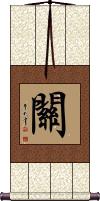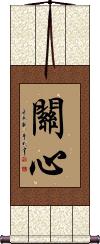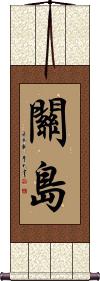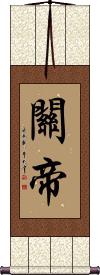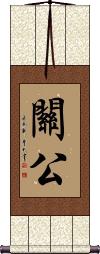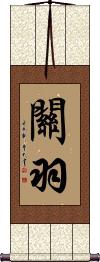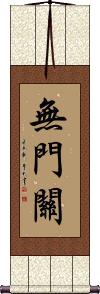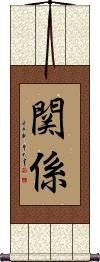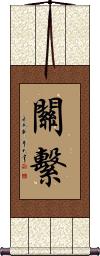Many custom options...
And formats...

關 in Chinese / Japanese...
Buy an 關 calligraphy wall scroll here!
Personalize your custom “關” project by clicking the button next to your favorite “關” title below...
Guan / Kwan / Seki
Surname
關 is a surname in three languages.
In Chinese, it romanizes as Guan.
In Korean, it's Kwan (or Gwan).
In Japanese it's Seki.
The meaning of the character is mountain pass; to close; to shut; to turn off; barrier; frontier.
Caring
關心 means caring in Chinese.
Caring is giving love and attention to people and things that matter to you and anyone who needs help. When you care about people, you help them. You do a careful job, giving your very best effort. You treat people and things gently and respectfully. Caring makes the world a safer place.
Note: 關心 is also a word in Korean Hanja, but in Korean, it means taking interest or concern. In Korean, it's still a good word, but it doesn't quite have the “caring for a person” meaning that it does in Chinese.
Guam
Guandi: God of War
Guan Gong / Warrior Saint
關公 is a Chinese title, Guan Gong, that means Lord Guan (The warrior saint of ancient China).
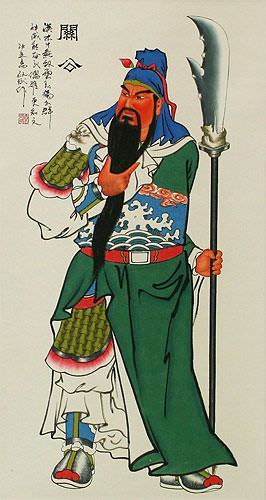 While his real name was Guan Yu / 關羽, he is commonly known by the title of Guan Gong (關公).
While his real name was Guan Yu / 關羽, he is commonly known by the title of Guan Gong (關公).
Some Chinese soldiers still pray to Guan Gong for protection. They would especially do this before going into battle. Statues of Guan Gong are seen throughout China.
Guan Yu
關羽 is the name Guan Yu, Army General for the Kingdom of Shu.
He is also known as Guan Gong (like saying Duke Guan or Sir Guan)
He was immortalized in the novel, “Romance of the Three Kingdoms.”
He was a fearsome fighter, also famous for his virtue and loyalty. He is worshiped by some modern-day soldiers and has the title “Warrior Saint” in China. Some believe he offers safety and protection for military servicemen.
Guan Yu lived until 219 A.D.
The Gateless Gate
無門關 is the ancient title for “The Gateless Barrier.”
This has both direct meaning and is the title of a 13th-century collection of koans, compiled by a Chinese Chan Master known as Wumen in China (known in Japan as Zen Master Mumon).
While this is the original title, you may see this written as 無門関 in Japan, where the last character, 關, was simplified to 関 after 1945.
Sisterhood / Sisters Relationship
Relationship
Most common Japanese version
The dictionary definition is:
relation, relationship, connection, participation, involvement, concern, influence, effect, related to, connected to, or as a suffix to sexual it can mean sexual relations or relationship.
But there's more to it...
In Japan, the relationship that you have with certain people can open doors for you. Having this relationship with someone also means they would never rip you off but instead are honor-bound to treat you fairly.
See our Chinese Guanxi entry for more information. This term is used in very similar ways in China, Japan, and Korea.
Guanxi
The Chinese Concept of Relationship and Exchange of Favors
The dictionary definition is:
Relations/relationship, to concern, to affect, to have to do with, or connection.
But there's more to it...
In China, the relationship that you have with certain people can open doors for you. Having guanxi with someone also means they would never defraud you but are honor-bound to treat you fairly (of course, this goes both ways). Sometimes it is suggested that guanxi is the exchange of favors. 關繫 / 関繫 / 關係 is more about having a relationship that allows you to ask for and expect favors without shame.
There is no concept in western culture that exactly matches guanxi, but perhaps having a social or professional network is similar.
Note that there are some variations common within Chinese, Japanese Kanji, and Korean Hanja for this word... Japanese tend to use a Chinese alternate form as shown to the right for
Japanese tend to use a Chinese alternate form as shown to the right for
the first character.
 There's also another alternate form of that first character (currently used as the official Simplified form in mainland China) which looks like the character shown to the right. It's basically the central radical of the alternate version shown above but without the “door radical” around it. In more free-flowing calligraphy styles, this version would be the likely choice for a calligrapher.
There's also another alternate form of that first character (currently used as the official Simplified form in mainland China) which looks like the character shown to the right. It's basically the central radical of the alternate version shown above but without the “door radical” around it. In more free-flowing calligraphy styles, this version would be the likely choice for a calligrapher.
![]() In Modern Japanese, they use the character shown to the right.
In Modern Japanese, they use the character shown to the right.
They also tend to use this same form in Korean Hanja (I've only checked this word in my Korean dictionary, but it has not been confirmed by a translator's review).
![]() If that was not confusing enough, there is another alternate form of that second character. See right.
If that was not confusing enough, there is another alternate form of that second character. See right.
An Asian calligrapher of any nationality may use these forms at their discretion. However, They would tend to stick to the most common form used in their respective languages.
If you have any preference on any of these issues, please give us a special note with your order, and we'll make sure it's done the way you want.
Not the results for 關 that you were looking for?
Below are some entries from our dictionary that may match your 關 search...
| Characters If shown, 2nd row is Simp. Chinese |
Pronunciation Romanization |
Simple Dictionary Definition |
關 关 see styles |
guān guan1 kuan seki せき |
More info & calligraphy: Guan / Kwan / Seki(surname) Seki To shut, a closed place, barrier, frontier; to include, concern, involve. |
關公 关公 see styles |
guān gōng guan1 gong1 kuan kung |
More info & calligraphy: Guan Gong / Warrior Saint |
關島 关岛 see styles |
guān dǎo guan1 dao3 kuan tao |
More info & calligraphy: Guam |
關帝 关帝 see styles |
guān dì guan1 di4 kuan ti Kantei |
More info & calligraphy: Guandi: God of War |
關心 关心 see styles |
guān xīn guan1 xin1 kuan hsin |
More info & calligraphy: Caring |
關羽 关羽 see styles |
guān yǔ guan1 yu3 kuan yü |
More info & calligraphy: Guan Yu |
無門關 无门关 see styles |
wú mén guān wu2 men2 guan1 wu men kuan Mumon kan |
More info & calligraphy: The Gateless Gate |
三關 三关 see styles |
sān guān san1 guan1 san kuan sankan |
three barriers |
上關 see styles |
kamiseki かみせき |
(surname) Kamiseki |
下關 下关 see styles |
xià guān xia4 guan1 hsia kuan |
Xiaguan district of Nanjing City 南京市 in Jiangsu 江蘇|江苏 |
不關 不关 see styles |
bù guān bu4 guan1 pu kuan fukan |
irrelevant |
事關 事关 see styles |
shì guān shi4 guan1 shih kuan |
to concern; on (some topic); about; concerning; to have importance for |
互關 互关 see styles |
hù guān hu4 guan1 hu kuan |
to follow each other on a social media platform (abbr. for 互相關注|互相关注[hu4 xiang1 guan1 zhu4]) |
井關 see styles |
izeki いぜき |
(surname) Izeki |
伊關 see styles |
izeki いぜき |
(personal name) Izeki |
偏關 偏关 see styles |
piān guān pian1 guan1 p`ien kuan pien kuan |
Pianguan county in Xinzhou 忻州[Xin1 zhou1], Shanxi |
入關 入关 see styles |
rù guān ru4 guan1 ju kuan |
to enter a pass; to go through customs |
公關 公关 see styles |
gōng guān gong1 guan1 kung kuan |
public relations |
剛關 刚关 see styles |
gāng guān gang1 guan1 kang kuan gōkan |
firm gate |
北關 北关 see styles |
běi guān bei3 guan1 pei kuan |
see 北關區|北关区[Bei3 guan1 Qu1] |
南關 南关 see styles |
nán guān nan2 guan1 nan kuan |
see 南關區|南关区[Nan2 guan1 Qu1] |
卡關 卡关 see styles |
kǎ guān ka3 guan1 k`a kuan ka kuan |
to be stuck; to feel stuck |
取關 取关 see styles |
qǔ guān qu3 guan1 ch`ü kuan chü kuan |
to unfollow (on social media etc) (abbr. for 取消關注|取消关注[qu3 xiao1 guan1 zhu4]) |
叩關 叩关 see styles |
kòu guān kou4 guan1 k`ou kuan kou kuan |
to knock at the gate (old); to make an approach; to invade; to attack the goal (sports) |
國關 国关 see styles |
guó guān guo2 guan1 kuo kuan |
abbr. for 國際關係學院|国际关系学院[Guo2 ji4 Guan1 xi4 Xue2 yuan4], University of International Relations, Beijing |
坐關 坐关 see styles |
zuò guān zuo4 guan1 tso kuan |
(Buddhism) to sit in contemplation |
城關 城关 see styles |
chéng guān cheng2 guan1 ch`eng kuan cheng kuan |
area outside a city gate |
報關 报关 see styles |
bào guān bao4 guan1 pao kuan |
to declare at customs |
壺關 壶关 see styles |
hú guān hu2 guan1 hu kuan |
Huguan county in Changzhi 長治|长治[Chang2 zhi4], Shanxi |
大關 大关 see styles |
dà guān da4 guan1 ta kuan oozeki おおぜき |
strategic pass; barrier or mark (i.e. a level considered impressive, usually a round figure such as 10,000); instrument of torture used to break limbs (surname) Oozeki |
Click here for more 關 results from our dictionary
The following table may be helpful for those studying Chinese or Japanese...
| Title | Characters | Romaji (Romanized Japanese) | Various forms of Romanized Chinese | |
| Guan Kwan Seki | 關 关 | seki | guān / guan1 / guan | kuan |
| Caring | 關心 关心 | guān xīn / guan1 xin1 / guan xin / guanxin | kuan hsin / kuanhsin | |
| Guam | 關島 关岛 | guān dǎo / guan1 dao3 / guan dao / guandao | kuan tao / kuantao | |
| Guandi: God of War | 關帝 关帝 | kan tei / kantei | Guān dì / Guan1 di4 / Guan di / Guandi | Kuan ti / Kuanti |
| Guan Gong Warrior Saint | 關公 关公 | guān gōng guan1 gong1 guan gong guangong | kuan kung kuankung |
|
| Guan Yu | 關羽 关羽 | guān yǔ / guan1 yu3 / guan yu / guanyu | kuan yü / kuanyü | |
| The Gateless Gate | 無門關 无门关 | mu mon kan / mumonkan | wú mén guān wu2 men2 guan1 wu men guan wumenguan | wu men kuan wumenkuan |
| Sisterhood Sisters Relationship | 姐妹關繫 姐妹关系 | jiě mèi guān xì jie3 mei4 guan1 xi4 jie mei guan xi jiemeiguanxi | chieh mei kuan hsi chiehmeikuanhsi |
|
| Relationship | 關繫 / 関繫 / 關係 関係 | kan kei / kankei | guān xì / guan1 xi4 / guan xi / guanxi | kuan hsi / kuanhsi |
| Guanxi | 關繫 / 関繫 / 關係 关系 / 関係 | kankei | guān xì / guan1 xi4 / guan xi / guanxi | kuan hsi / kuanhsi |
| In some entries above you will see that characters have different versions above and below a line. In these cases, the characters above the line are Traditional Chinese, while the ones below are Simplified Chinese. | ||||
Successful Chinese Character and Japanese Kanji calligraphy searches within the last few hours...
